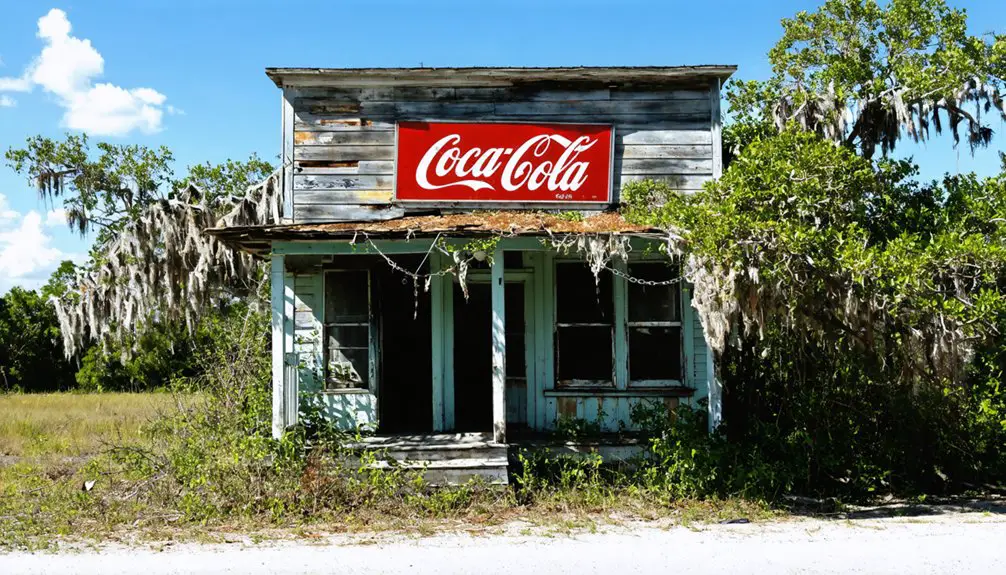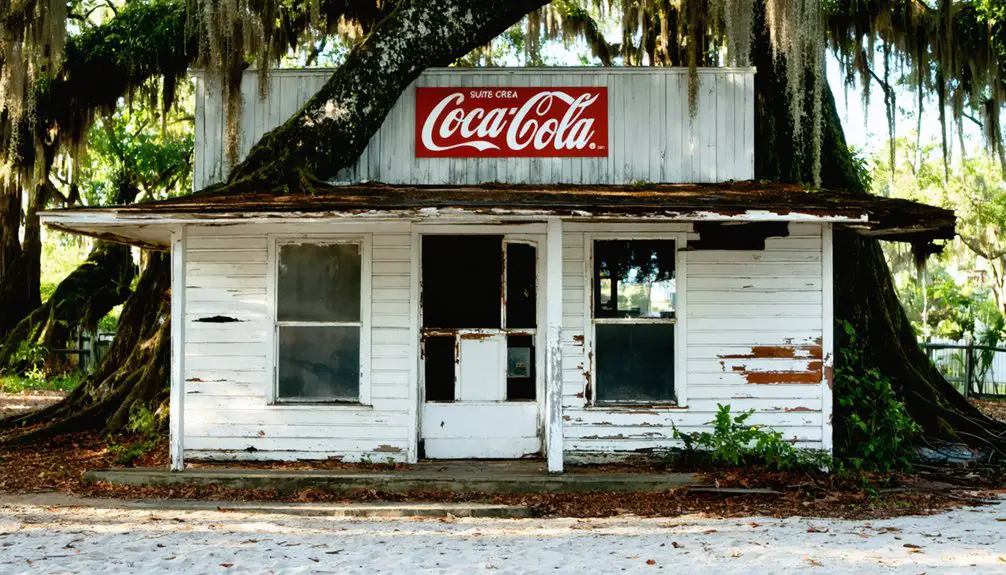You’ll find Ethel’s ghost town remains in Lake County, Florida, where the Moore family established a 360-acre settlement in the late 1860s. The town thrived as a railroad flag stop with a peak population of 10,800, supported by farming and skilled trades. The devastating Great Freeze of 1895 destroyed the citrus industry, causing land values to plummet from $1,000 to $10 per acre. Today, the historic Ethel Cemetery and ongoing restoration efforts preserve this post-Civil War community’s legacy.
Key Takeaways
- Ethel was established in the 1860s by the Moore family, reaching a peak population of 10,800 before declining into a ghost town.
- The Great Freeze of 1895 devastated citrus crops, causing land values to plummet and triggering mass exodus from the community.
- Only the Ethel Cemetery remains, with three surviving headstones marking the Boyd family’s legacy in this abandoned settlement.
- The town relied heavily on its railroad station for supplies and mail, but declined with the rise of automobiles.
- The Ethel Restoration Project now works to preserve the historic post-Civil War township through education and archaeological efforts.
The Rise of a Post-Civil War Settlement
When the Moore family arrived from Eastern Georgia in the late 1860s, they established the foundation for what would become the settlement of Ethel, Florida. They acquired 360 acres, setting a precedent for postwar agriculture in the region.
William and Charlotte Moore, along with their son Newton, became permanent fixtures of the community until their deaths in the early 1880s.
The Moore family anchored themselves in Ethel’s early development, shaping the community’s character until their passing in the 1880s.
You’ll find that land ownership patterns shifted markedly after the Civil War. Former Union soldier William Delk freed his enslaved workers, while freed African Americans like Joseph Robards and Anthony Frazier purchased their own land. At its peak in 1870, Ethel reached a population of 10,800 residents.
The Homestead Act provided newcomers with 140 to 160 acres, requiring them to build homes and cultivate the land. This postwar redistribution transformed the area into a mosaic of small farms and homesteads.
The railroad construction in 1886 brought new opportunities and helped establish Ethel as a thriving community.
Daily Life in Early Ethel
Life in early Ethel centered around the railroad station, which served as the community’s essential connection to the outside world. You’d find residents gathering at the station during flag stops, awaiting supplies and mail that sustained their daily routines.
As a farmer, carpenter, or teacher, you’d spend your days working alongside neighbors in this close-knit settlement. Community gatherings often took place near the post office, where you’d exchange news and collect mail. The local sawmill operations provided jobs and materials for the growing town.
Your survival depended on the railroad’s lifeline, bringing necessities you couldn’t produce on your own farm. When not tending to livestock or crops, you might’ve worked as a machinist, photographer, or ferry operator. People avoided cooking during midday by preparing meals early, storing their food carefully under tablecloths to keep it fresh.
The town’s simple infrastructure supported basic needs, while the cemetery served as a memorial to the community’s enduring bonds.
The Town’s Notable Families and Citizens
Among Ethel’s most influential pioneers, you’ll find the Moore family who first settled the area in the late 1860s with 360 acres of farmland near what became the town cemetery.
The Boyd family joined the early community and left their mark through multiple generations buried in the cemetery, including William Moore’s burial in 1882 as the first recorded interment.
The town’s residents worked diverse occupations beyond farming, as evidenced by census records showing carpenters, machinists, photographers, and teachers who contributed to Ethel’s development. At its peak, the thriving community supported a population of 250 residents.
Moore Family Pioneers
The Moore family established themselves as pioneering settlers of Ethel during the post-Civil War era, with William and Charlotte Moore leading the initial homesteading efforts.
You’ll find evidence of their Moore lineage through the tombstones of Luke, William, and Charlotte in the Ethel Cemetery, discovered by Tony Moore, a retired land surveyor with no direct relation to the pioneer family.
The pioneer contributions of the Moores helped shape Ethel’s early development through farming and community building. They were part of a diverse settlement that included carpenters and teachers, supported by a flag stop train station. The restoration of their 19th century cabins will provide visitors with authentic glimpses into settler life.
Though many residents left after the devastating 1895 freeze, the Moore family’s legacy lives on through preservation efforts, including interpretive trails and educational materials that commemorate their role in Ethel’s history. Visitors can explore their story along the 1.4 mile trail that loops through the former settlement.
Boyd Cemetery Legacy
While Ethel Cemetery stands as the oldest known burial ground in Lake County, established around 1880, it’s perhaps best known for preserving the legacy of notable families like the Boyds.
Joseph, James, and Mini Boyd’s graves represent more than just markers – they’re monuments to the Boyd family’s significant role in shaping Ethel’s early community legacy. The tragic death of Joseph A. Boyd at just one year old in 1918 serves as a poignant reminder of the era’s harsh realities.
The cemetery reveals important aspects of the Boyd family’s presence:
- Their graves were among the few marked tombstones discovered during recent preservation efforts
- The Boyd family maintained strong connections to other prominent settlers through documented land ownership
- Their presence helped establish Ethel’s social framework during the late 19th century
- The family’s burial site has sparked renewed interest in uncovering the town’s broader historical narrative
Today, with only three headstones remaining in the cemetery, preserving these historical markers becomes increasingly crucial for future generations.
Early Resident Occupations
Early settlers in Ethel cultivated diverse economic foundations through farming, skilled trades, and service-oriented professions during the town’s peak years.
The Moore family pioneered agricultural innovations on their 360-acre homestead, raising crops and livestock that sustained the community. Finley B. Click demonstrated skilled craftsmanship by constructing cabins with hand-carved cedar shingles and operating a local store.
You’ll find that residents adapted to challenges, particularly after the devastating freeze of 1894-95 forced them to diversify beyond citrus farming.
The town’s workforce included carpenters, machinists, photographers, and railroad workers. Many crafted their own furniture from local wood, while others maintained essential services through the post office, one-room schoolhouse, and railway station, showcasing the self-sufficiency that defined Ethel’s peak period.
Transport Hub: Flagging Down Progress

As railroads expanded across Florida in the late 19th century, Ethel’s flag stop station emerged as an essential lifeline for this small rural community.
With no early roads connecting to larger towns, you’d rely on the railroad for everything from mail to supplies. The station’s railroad significance went beyond basic transport – it sparked the growth of crucial community services by 1888. Similar to the Florida Railroad line that connected Fernandina to Cedar Key, this station was vital for local commerce.
Key elements of Ethel’s transport evolution:
- You’d signal passing trains with a flag to request a stop
- The rail connected you to Mount Dora, Sanford, and Wekiva
- Your community connection centered around the station’s post office and general store
- Travel obstacles like swamps required elevated tracks and trestles
This transport hub’s prominence faded as automobiles and roads gained popularity, contributing to Ethel’s eventual ghost town status.
Nature’s Wrath: The Great Freeze of 1895
You’ll find the Great Freeze of 1895 marked a devastating turning point for Ethel’s citrus industry, as temperatures plunged well below freezing, splitting mature tree trunks from top to bottom and destroying decades-old groves within days.
The catastrophic freeze caused land values to plummet from $1,000 to just $10 per acre, forcing many of Ethel’s citrus farmers into financial ruin.
Faced with devastating losses and uncertain prospects for recovery, numerous families abandoned their groves and departed Ethel, initiating the community’s gradual descent into ghost town status.
Devastating Citrus Industry Impact
The devastating Great Freeze of 1895 struck Florida’s citrus industry with two catastrophic blows, forever altering the state’s agricultural landscape.
You’d have witnessed the citrus collapse unfold in two stages: first in December 1894, killing fruit and foliage, then the knockout punch in February 1895, when temperatures plunged to 7-18°F, splitting tree trunks and destroying nearly all citrus trees.
The economic devastation was staggering:
- Production crashed from 6 million boxes to just 100,000
- Land values plummeted from $1,000 to $10 per acre
- Packinghouses and infrastructure faced total collapse
- Recovery took over a decade to achieve
Small growers couldn’t survive the seven-year wait for new trees to mature.
The industry shifted southward, forcing many farmers to abandon their land or leave Florida entirely, transforming once-thriving communities into ghost towns.
Mass Community Exodus Begins
When devastating cold fronts swept through Florida in late 1894 and early 1895, they triggered an unprecedented mass exodus from once-prosperous citrus communities.
You’d have witnessed the systematic collapse of community resilience as temperatures plunged to 11°F in Tallahassee and 19°F in Orlando, destroying groves that families had tended for decades.
The migration patterns that followed were swift and decisive.
As land values crashed from $1,000 to mere $10 per acre, you’d have seen your neighbors abandoning their properties, heading west for better opportunities.
The devastating one-two punch of December and February freezes left no choice for many.
While some coastal areas like Clearwater showed resilience, inland communities like Ethel saw their populations dwindle as families sought new beginnings beyond Florida’s borders.
From Bustling Community to Abandoned Dreams

During its peak in the late 1800s, Ethel flourished as a diverse rural settlement where farmers, railroad workers, and craftsmen built their lives around agricultural pursuits and rail commerce.
The community’s cultural significance stemmed from its remarkable blend of trades and professions, showcasing the community resilience of Florida’s pioneering spirit.
A diverse blend of tradespeople and professionals showcased Florida’s pioneering resilience, weaving a rich cultural tapestry in this historic settlement.
You’ll find the town’s transformation from vibrant to vacant was marked by these crucial changes:
- The devastating freeze of 1895 destroyed essential citrus crops
- Residents abandoned their homes, taking only essentials
- By 1920, only ten homes remained occupied
- The rise of automobiles diminished railroad dependency
The once-bustling community gradually faded as economic hardships and transportation shifts forced families to seek opportunities elsewhere, leaving behind abandoned dreams and empty homesteads.
Modern Traces: The Historic Ethel Cemetery
Hidden within Rock Springs Run State Reserve lies Ethel Cemetery, Lake County’s oldest known burial ground dating back to 1880.
You’ll find this historic one-acre site nestled among wilderness where deer, turkeys, and bears roam freely. While only three visible tombstones remain today, including those of Luke H. Moore and Union Army veteran Anthony Frasier, historical records suggest up to 100 individuals rest here.
The cemetery’s historical significance stems from its connection to the ghost town of Ethel, representing a diverse community of early settlers, freed slaves, railroad workers, and craftsmen.
Today, grave preservation efforts led by the Wekiva Wilderness Trust focus on protecting and documenting this sacred ground. If you visit, remember it’s protected by state law – no metal detecting or artifact removal is permitted.
Rebuilding the Past: The Ethel Restoration Project

After discovering tombstones of early settlers William and Charlotte Moore, the Ethel Restoration Project took shape as an ambitious initiative to rebuild and preserve this forgotten post-Civil War township.
Through historical preservation efforts, you’ll find volunteers and researchers working to reconstruct authentic 19th-century homesteaders’ log cabins using salvaged period materials.
The project’s community engagement extends beyond physical reconstruction:
- Archaeological fieldwork and land surveys map the original town layout
- Skilled craftsmen replicate historic building techniques for authenticity
- Local volunteers conduct extensive archival research and artifact discovery
- Educational programs offer hands-on learning about pioneer life
Through the Wekiva Wilderness Trust’s dedication, you’ll soon witness this ghost town transform into a living history exhibit, showcasing the architectural styles and daily life of Central Florida’s early settlers.
Frequently Asked Questions
Were There Any Native American Settlements in the Ethel Area Before Colonization?
You’ll find evidence of Native tribes through historical artifacts in the area, as Timucua and Seminole peoples established settlements near waterways around present-day Ethel before European colonization.
What Happened to the Buildings and Structures After the Town Was Abandoned?
You’ll find most abandoned structures decayed naturally over time, with wooden buildings rotting away. No historical preservation efforts existed then, leaving only scattered artifacts and foundation remnants in the wilderness today.
Did Any Supernatural or Paranormal Activity Occur in Ethel’s Abandoned Areas?
Over 50 documented ghost sightings have occurred since 1900. You’ll find reports of Ethel Allen’s spirit in haunted locations like bathrooms and stairways, where witnesses describe being pushed and experiencing choking sensations.
What Was the Average Property Value of Homes in Ethel’s Prime?
You’ll find exact property valuations weren’t formally recorded, but homes reflected basic homestead costs plus land improvements. Values declined with economic hardship, ranging from initial $18 filing fees to modest agricultural-based worth.
Were There Any Notable Crimes or Legal Disputes in Ethel’s History?
Like a dark stain on history’s fabric, you’ll find one major crime stands out: the brutal 1934 murder of Ethel Allen. Beyond this notorious case, there weren’t other significant legal disputes documented.
References
- https://www.thehistorycenter.org/rediscovering-ethel/
- https://www.youtube.com/watch?v=zgf6tE2mrCU
- https://www.youtube.com/watch?v=mb0SLX0qIA8
- https://floridahikes.com/historic-ethel-trail/
- https://www.blackfacts.com/fact/ethel-project-aims-to-bring-19th-century-ghost-town-back-to-life
- http://elhs.synthasite.com/ethel.php
- https://www.hmdb.org/results.asp?Search=County&County=Lake+County&Georgia&Kentucky&MississippiOklahomaTennesseeGeorgiaKentuckyGeorgiaGeorgiaTennesseeTennesseeGeorgiaGeorgiaTennesseeTennesseeTennesseeIllinoisFloridaGeorgiaFloridaFloridaGeorgiaMississippiTennesseeTennesseePennsylvaniaMississippiMississippiNew+JerseyArMissouriMississippiTennesseeGeorgiaNorth+Carolina&State=Nevada&DP=-O.A&Page=2
- https://www.floridastateparks.org/learn/historic-town-ethel
- https://blackfacts.com/fact/ethel-project-aims-to-bring-19th-century-ghost-town-back-to-life
- https://www.youtube.com/watch?v=0C9899I_vfM



